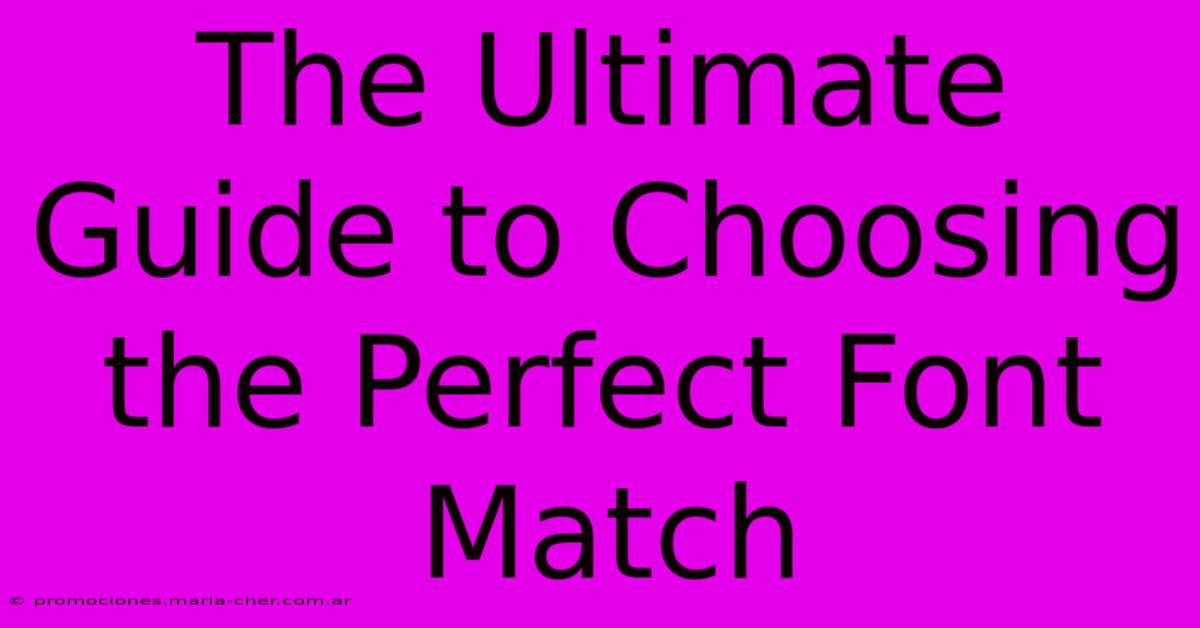The Ultimate Guide To Choosing The Perfect Font Match

Table of Contents
The Ultimate Guide to Choosing the Perfect Font Match
Choosing the right font pairings can make or break your design. A harmonious font combination enhances readability and creates a visually appealing aesthetic, while a clashing pairing can leave your audience feeling confused and frustrated. This ultimate guide will equip you with the knowledge and techniques to select the perfect font match for any project, whether it's a website, marketing materials, or a book.
Understanding Font Families and Classifications
Before diving into pairings, let's establish a foundational understanding of font families. Fonts are categorized into various classifications based on their style and characteristics. These include:
-
Serif: These fonts have small decorative strokes (serifs) at the ends of letters. They often convey a classic, traditional, and sophisticated feel. Examples include Times New Roman, Garamond, and Georgia.
-
Sans-serif: These fonts lack serifs, appearing cleaner and more modern. They're often used for headlines, body text in digital environments, and contemporary designs. Examples include Arial, Helvetica, and Open Sans.
-
Script: These fonts mimic handwriting, offering a personal and elegant touch. They're best used sparingly, often for headings, logos, or special emphasis. Examples include Edwardian Script ITC and Pacifico.
-
Display: These fonts are highly stylized and decorative, ideal for eye-catching headlines and logos. They're generally not suitable for large blocks of text. Examples include Impact, Bebas Neue, and Lobster.
-
Monospace: All characters in these fonts occupy the same horizontal width, commonly used for coding and technical documents.
Key Principles for Successful Font Pairing
The secret to successful font pairing isn't about random selection; it's about creating visual harmony and enhancing readability. Here are some key principles to follow:
1. Contrast, but with Harmony
Pair fonts that offer a visual contrast, but maintain a sense of unity. For instance, combine a serif font (for body text) with a sans-serif font (for headings). The difference in style creates visual interest, while their overall aesthetic prevents a jarring effect.
2. Consider Weight and Size
Varying font weight (light, regular, bold) and size adds depth and hierarchy to your design. Use bold weights for headlines to draw attention and lighter weights for body text to improve readability. Ensure there's sufficient size difference between headings and body text for clear distinction.
3. Think About the Context
The ideal font pairing depends heavily on your project's context. A playful script font might work well for a wedding invitation, but it would be inappropriate for a legal document. Consider your target audience and the overall message you want to convey.
4. Limit Your Palette
Resist the temptation to use too many fonts. Sticking to two or three fonts, at most, keeps your design clean and avoids visual clutter. One font for headings and another for body text is often sufficient.
5. Test and Iterate
Don't be afraid to experiment! Try different combinations, view them at various sizes and on different devices, and solicit feedback. The perfect pairing often emerges through trial and error.
Popular and Effective Font Pairings
Here are some examples of popular and effective font pairings that work well together:
- Playfair Display + Open Sans: Elegant serif paired with a clean sans-serif.
- Lora + Montserrat: Classic serif with a modern geometric sans-serif.
- Merriweather + Roboto: A slightly more informal serif with a friendly sans-serif.
- Oswald + Source Sans Pro: A bold display font complemented by a highly legible sans-serif.
Tools and Resources for Font Pairing
Several online tools can help you explore and discover potential font pairings:
- Google Fonts: A vast library of free, open-source fonts.
- Adobe Fonts: A comprehensive collection of fonts available through a subscription.
- FontPair: A website dedicated to suggesting font pairings.
Conclusion: Mastering the Art of Font Pairing
Choosing the perfect font match is a crucial aspect of design. By understanding font classifications, applying key principles, and iterating through different combinations, you can create visually stunning and highly readable designs that resonate with your audience. Remember to prioritize clarity, consistency, and overall aesthetic harmony to achieve truly impactful results.

Thank you for visiting our website wich cover about The Ultimate Guide To Choosing The Perfect Font Match. We hope the information provided has been useful to you. Feel free to contact us if you have any questions or need further assistance. See you next time and dont miss to bookmark.
Featured Posts
-
The Aqua Awakening How This Hue Can Lift Your Spirits And Enhance Well Being
Feb 10, 2025
-
Unlock The Power Of Prayer For The Worlds Most Vulnerable Children
Feb 10, 2025
-
Elevate Your Style 9 Fashion Hacks That Will Make You The Envy Of The Town
Feb 10, 2025
-
Unleash Your Inner Hero The Ultimate Guide To D And D Nail Colors
Feb 10, 2025
-
Dear To Whom It May Concern Hilarious Signature Lines To Spice Up Your Formal Emails
Feb 10, 2025
